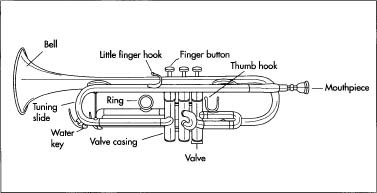"You can't possibly hear the last movement
of Beethoven's Seventh and go slow."
AUTHOR: Oscar Levant
(explaining his way out
of a speeding ticket)
(explaining his way out
of a speeding ticket)
MEANING OF THE QUOTE:
"Music has the power to alter your behavior depending
on the type of music you are listening to."
"Music has the power to alter your behavior depending
on the type of music you are listening to."
COMPOSER
ANDERSON
A TRUMPETER'S LULLABY
Wynton Marsalis, Trumpet
A TRUMPETER'S LULLABY
Leroy Anderson had a strong relationship
with the Boston Pops Orchestra. After
one concert, Roger Voisin,
principal trumpet, asked Anderson
to write a trumpet solo different from
the usual loud, martial, or triumphant
works in existence. Anderson
wrote about the request:
"After thinking it over, it occurred to me that I had never
heard a lullaby for trumpet, so I set out to write one with
a quiet melody based on bugle notes played by the trumpet
and with the rest of the orchestra playing a lullaby background."
This delightful composition, for solo
trumpet and ensemble, lives up to the
definition of a lullaby: a song to quiet
children or lull them to sleep. The
opening andante tranquillo section
"rocks" the child to sleep. A short
piu animato section recalls the child's
dreams of active play before the original
tempo returns and the child is fast asleep.
 |
| Trumpet |
BUGLER'S HOLIDAY
Lewisham Concert Band, 2011
BUGLER'S HOLIDAY
Canadian Brass
with Victoria Hall
BUGLER'S HOLIDAY
This arrangement of Bugler's Holiday
features a trumpet trio with band
accompaniment. This brisk piece allows
the performers to show off their
articulation, intonation, and ensemble
playing. Since its composition in 1954,
it has motivated many trumpeters to
improve their technique of double tongu-ing
and the quality of their bell tones.
 |
| Bugle |
Though the Bugler's Holiday is performed
by trumpets the question might be asked:
BUGLES and TRUMPETS
WHAT IS THE DIFFERENCE?
The basic difference between bugles and
trumpets is found in the shape of the bell.
The musical definition of a trumpet (natural
trumpet) is that of a horn which has two
thirds of its length in the form of a cylindrical
tube (meaning the tubing stays the same size
through most of the instrument, only getting
larger at the bell) usually it is five sixths of the
total length. A bugle has a conical shape
through-out (meaning that the tubing gets
gradually larger throughout the
length of the instrument).

Trumpet
Bugle
The shape of the bell plus the shape of the
mouthpiece produces a different quality of
sound in each. The trumpet is known for its
bright, strident, brash sound, while the bugle
is known for its darker and mellower tone.
Today, the term "bugle" can simply mean a
brass instrument without valves or slides.
Bugles have no valves like the trumpet and
can thus can only produce a limited number
of notes found in the harmonic series of a
single fundamental tone. All musical sounds
that we hear contain overtones (harmonics),
or tones that resonate in fixed relationships
above a fundamental frequency.

Being without valves made the instrument
practical for its use in military-style signaling
(like Taps or Reveille) of times past.
Bugles are traditionally
in the key of G.
LINKS






